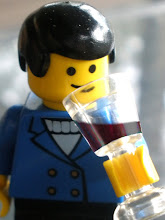
A vineyard at Nepenthe in the Adelaide Hills, one of Australia's best known makers of sauvignon blanc.
As I gaze over the historical first month of Australian Wine Journal, it occurs to me that sauvignon blanc has the most posts. Don't fret serious wine drinkers - this trend won't last long, things just turned out that way.
What I will do is take this opportunity to discuss the fashionable variety, from a young consumers point of view.
Marlborough (New Zealand of course) Sauvignon Blanc is the number 1 selling bottled wine in Australia today, which saddens me considerably. I like the stuff, I really do, but how or why we let the Kiwis become number 1 in Australia is beyond me.
Why so popular?
I was listening to a radio interview with Adelaide's wine writer in residence Andrew Jefford recently, who suggested a good part of Marlborough' s Savvy popularity was because the wines speak of terroir (honestly though, I wouldn't be surprised if he thought Paris Hilton's popularity was due to terroir). I agree with Mr Jefford that the sauvignon blanc of Marlborough reflects distinct regionality, especially given its easy drinking nature and price, but I have to at least partly disagree that this is why the style is so popular in Australia.
Now I don't know about Andrew Jefford, but most of my friends and associates are either teenagers, twenty-somethings or in their early-mid thirties, and almost all of them choose sauvignon blanc as either their wine of choice, or white of choice. NONE of these people are familiar with the concept of terroir. In fact, if a Marlborough Sauvignon Blanc was unavailable they'd be just as quick to buy a bottle of Lindemans Bin 95 (not exactly the most site specific wine around, you'd be lucky if it even tasted like sauvignon blanc).
Some of these people aren't even familiar with the concept of vintage (i.e. they think when they buy a bottle of Giesen they're getting the same product year-in, year-out, much like they would with beer or pre-mixed spirits) and some think being familiar with Marlborough sauvignon blanc makes them a sophisticated wine drinker.
The retail industry plays a big part in the popularity of Marlborough's sauvignon blanc, as these wines are very well represented on store shelves.
Over summer, a friend and I were at a Dan Murphy's store looking for a chilled sauvignon blanc for immediate drinking. In Dan's fridge was roughly 20 cold sauvignon blancs, of these, only two or three were Australian, the rest from New Zealand. This trend repeats itself not just in stores across the country, but also in pubs, restaurants and cafes, where a Marlborough Sauvignon Blanc is virtually mandatory on any modern wine list, more so than any Australian wine style. In fact, just this minute, there's an ad for Nobilo Sauvignon Blanc on TV right now (thanks Sip'n'Save). This aggressive marketing and sales pitching from our own people makes it easy for the average Aussie drinker to grab that bottle of Marlborough at every opportunity.
To me, sauvignon blanc appeals to its fan base for similar reasons as to why low-carb beer and alco-pops do, that is; relatively uncomplicated, forward, fruity flavours which make them easy to drink (especially cold), clever marketing and perceived image. The public's perceived image of New Zealand that is.
When people think of New Zealand they think of snowcapped mountains, lush green countryside, long white clouds, untouched landscapes, sparkling rivers, clean water; and yes, clean, crisp, fresh white wine. Fortunately for the Kiwis, the wines of Marlborough actually do express their beautiful natural environment, and consumers have come to expect it.
In my opinion, the Australian region best suited to match these consumer perceptions of untouched natural beauty is clearly Tasmania.
Many beer drinkers, myself included, already associate the Tasmanian ideals of an isolated land of natural beauty, beset with clean, crisp, clear water, with every mouthful of Cascade, James Boag or Moo Brew we consume. If Tasmanian producers could draw further upon these consumer perceptions, and market it with the already astronomically popular sauvignon blanc, New Zealand's strong market share could face a legitimate threat.
Unfortunately, Tasmanian conditions haven't traditionally favoured the mass production of wine, as anyone trying to take on Marlborough must surely be able to produce large amounts of sauvignon blanc. But the onset of global warming seems to be improving conditions on the island state, where its producers seem to be enjoying glorious vintage after glorious vintage, at a time when Australia's mainland producers continuously contend with issues such as drought, bushfire, frost and excess heat.
The controversial pulp-mill group, Gunns Limited, is one such company which has already attempted to make large scale, affordable Tasmanian wine (75,000 cases annually), with their Tamar Ridge Devil's Corner label. I didn't much like their 2008 Pinot Noir, but their 2008 Sauvignon Blanc (90pts) showed exactly what can be achieved in Tasmania given the economies of scale and climatic conditions. For $12 a bottle at some outlets, it's a deliciously clean, fresh and racy example of a grassy, cool climate sauvignon blanc, which outperforms almost all other Australian savvys at the price.
I will continue to watch the development of Devil's Corner with keen interest. A marketplace full of cleverly marketed, fresh and ready, terroir driven Tasmanian sauvignon blanc at generous prices, could see us reclaim our No.1 back from the Kiwis.
I've got a hell of a lot more to say on this issue but I'm going to leave it here. I will however, return to the sauvignon blanc topic at a later date soon.

No comments:
Post a Comment